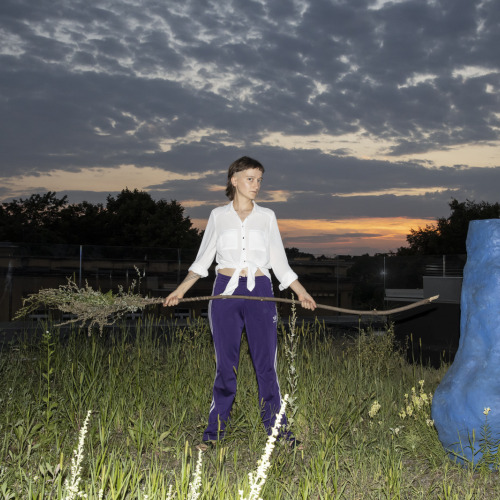
Exchanging blood for ink
The Austrian avant-garde filmmaker Mara Mattuschka,
who was born in 1959 in Bulgaria, and at the age of 17, as a mathematical
wizard, chose Austrian as her second citizenship, is one of the most important
figures in experimental film in Europe. She is also the connecting link between
Valie Export and the younger generation of experimental Austrian filmmakers.
The most impressive point of her numerous films, and in the
latest period video productions (Id, Plasma), is the way she relates to
her body. Not only has Mattuschka been the main protagonist on camera in each
of her (video) films, since 1985, when she bears the name Mimi Minus, her body
is also the canvas, object and subject that is painted, stretched, shaved,
deformed with special effects, etc. The other point of reference in her work is
a persistent and powerful analysis of past and present experimental and
Hollywood film productions, with intensive research into sound and music. Not
only does she interpret her texts in the films, she also sings, shouts and
integrates sound in different forms in her work, in most of cases as an
acousmatic voice, although in the case of Mattuschka, this voice is invisible,
but embodied, and subverts the narrative link (the authority) in the image.
In the mid-1980s she produced excellent animations, and
edited animated film scenes with body movements, empowering her body and body
parts. This is always paralleled in relation to film and experimental
practices. So, when we think about Kugelkopf /Ballhead (1985), it is
true that there is a profound relationship with modern printing technology, but
also a very powerful reference to Bunuel's Un Chien Andalou. But to
really understand the film we have to take into account the performances of
Gunter Brus, from the Viennese aktionists movement, and the tradition of
expressive Dadaist graphic arts. This is very crucial, as it exposes the
geniality of Mattuschka when dealing with black and white sequences in her
experimental films. Each sequence is not only a narration of the female and
engendered body that plays with obscenity and kitschy references, but also
presents the power of the virtuoso transposition of radical visual languages
into experimental film. Each sequence in the film is like a rereading of a
Dadaist composition or expressionist graphic art. This is why in Ballhead
instead of blood - (although the film relates to Brus and to French films after
the Second World War which included images of shaved Jewish women prisoners in
concentration camps, and also the punishment of women Nazi-collaborators), -
she uses ink. Mattuschka exchanges blood for ink, while shaving and slitting
her head with a razor, because she exchanges simple existence for the invention
of the language of experimental film. This ink is also the narration of one of
her fist experimental and animated films Les Miserables (1987). Black,
white and grey is used in many of Mattuschka's films, as if a child, argues
Stephan Settele, "with dirty fingers had taken the exposed roll of film
outside to play."
In Mattuschka's works cinematic tricks and animation are as important as her
tears, sweat, vaginal excretions, and sperm. These are always used to produce a
kind of double negativity of a proper body, which changes from a baby face
(Pascal Gödel, 1986) to experimental and dramatic characters (Parasympathica,
1986), from Godzilla-woman masturbating with the Eiffel Tower (S.O.S.
Extraterrestria, 1993) to middle-age housewives who are professors (Unternehmen
Arschmaschine, 1997).
When as a contemporary King Kong, she tenderly takes a woman
into her hand, it is just one of many images that come from the moving image
industry. What is important to understand is that under the feminist, radical posture
that Mimi Minus adopts in each of her films, which are melodramatic, defamed by
infantile sounds and absurd costumes, adorned with make-up-persiflage and
grotesque body-art performances (as catalogued by Stefan Grissemann), the
analysis of film history, experimental and avant-garde visual productions
remains, along with critique of science (e.g. biotechnology as in Unternehmen
Arschmaschine/Project Arse Machine, 1997, in collaboration with
Gabriele Szekatsch). This is why to this patriarchal science in Unternehmen
Arschmaschine, Mattuschka offers her buttocks as a delicious jelly, hoping
perhaps that as she was singing in Les Miserables in the end "All's
well that ends well." But times change, and we know that this is not
true, as nothing in the end is good any more (Id, 2003).
Marina Grzinic
Organisation: City of Women & Kinodvor
In co-operation with: Klub Gromka, AKC Metelkova mesto
With the support of: Sixpack Film


